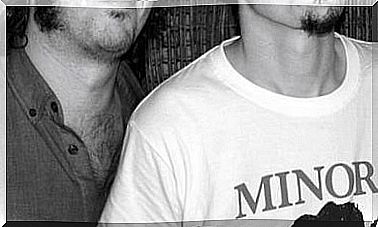“Stories Order The World”
Bernardo Ortín shows the therapeutic value of stories and how to use them.

Gregory Bateson tells how a computer genius was once asked if computers could think like a human being. The scientist went to work and designed a highly complex artificial intelligence program to prove it. When it was ready, the computer began to perform its operations. At the end, the first message that could be read on the screen was: “This reminds me of a story …”.
Bernardo Ortín and Trinidad Ballester love stories and know their healing effects. The stories also led me to their doorstep and they captivated me with their erudition, with their ability to highlight the obvious and return, from thought, to the sensory through stories and drawings. His work shows how art and writing are therapeutic tools and how our troubled modern world has forgotten the craft of cultivating health.
On the occasion of the workshop held every year in Barcelona, I was able to interview Bernardo about his work and the book he has written together with his wife, Trinidad. Doctor of Philosophy, therapist and trainer of Neuro-Linguistic Programming, Bernardo is the author of some of the most successful books in the field of therapeutic stories.
Occurring and good conversationalist, he peppered his presentations with anecdotes and stories, making it clear that he and his partner are passionate about caring for people from an integral perspective.
How do stories heal us?
– Can a story heal? How do you explain that?
– The stories help to unblock a too rigid perception of life. An existential conflict is constituted as much by the problem itself as by the occasions in which we have tried to solve it without success. We often do over and over again what we already know is not working and that makes the situation more and more rigid. In the language of the stories, that would be equivalent to falling into a spell that inaugurates our suffering.
For example, let’s imagine that our son at puberty does not study. We ask you to do it, and if you don’t, we ask you again, louder, clearer, in different, increasingly threatening ways. As that did not work, we took away the mobile phone, the internet, we stopped smiling and hugging him … With this, the coexistence in the family “kingdom” deteriorates and thus we build two problems: that of studies and the family climate.
– What could the parents do in this case?
–In such a situation, they could explain one or more stories. A story is not an instruction manual, it is a story that happened in another time and place and that had a development that was rich and complex enough not to show a single path.
– So the story acts indirectly?
-The story avoids confrontation with what the person thinks, since apparently it has nothing to do with what happens to her. And in stories we can manage time, as when a character from the future describes how a tragedy ended so that the listener can better accept it.
“The stories help to formulate the objectives well and to temper the desires, they encourage us to continue living in the face of great difficulties.”
Like the famous story of the frogs that fell into a bucket of milk and kicked relentlessly for fear of drowning until they turned the milk into butter. So they were able to get out of there.
– Does love always triumph in stories?
-No. Some stories teach that love can do everything and others, on the other hand, can show that love itself is not enough, that it has to arrive on time, as the genie of the lamp said when he wanted to kill Aladdin when he freed him from his encierro: “It is that for five hundred years I have been waiting locked up for this rescue.” The important thing about the story is not that it ends well or badly, but that it leaves the listener in a state of greater vitality.
The role of stories in therapy
–What led you to use the stories in therapy?
– I have always been interested in stories. Trini and I met at a writing workshop. She paints, writes and is interested in stories as a doctor, from her integral conception of health. I am fascinated by how people change, learn skills or behaviors, and experience emotions.
Stories are the oldest knowledge transmission tool in the world. There are two great schools of deep learning, one is the one that understands that the teacher, who is the one who knows, teaches the student who does not know ( educare ). The other affirms that what people need to know is already within them, so that the teacher should only dedicate himself to extracting that wisdom ( exducere ).
Socrates, for example, did not teach theories, what he did was ask his students questions so that they reasoned philosophically. He told them stories and myths about the things that had happened for the first time in the universe. Stories have the ability to order the world, to give meaning to existence. My interest in stories comes from the possibility they have to suggest a model of the world to people.
–You talk about stories, heroes and spells, can stories be extrapolated to people’s daily lives?
–The perception we have about our existence unfolds in two planes, one is practical and concrete, while the other is mythical and transcendent. When we have a conflict, a part of our attention is directed to the concrete development of the problem: what happened, what did I tell him, what did he tell me, causes and consequences, among other things.
However, another part of the imagination turns to the transcendent: think of the communication difficulties in the couple, in the abstract. So we combine what happens to us every day with the transcendent. At that point of fusion between the daily and the eternal is the influence of the story.
I remember a short story by Kostas Axelos that says: “A centaur father and mother contemplate their son, who is playing on a Mediterranean beach. The father turns to the mother and asks: –Should we tell him that it is only a myth? ? “
– What things can this work contribute to health professionals?
– What good doctor does not use metaphors to make himself understood? Health is an inexhaustible source of stories about what diseases mean for the patient. These stories often explain how difficult it is for professionals to do their jobs.
Doctors use the stories to help patients take charge of their own health. Somewhere I heard a story that sounds like this to me:
–You have Liberman’s disease.
“Is it serious, doctor?”
“We don’t know yet, Mr. Liberman.”
Therapeutic writing workshops
– Can storytelling workshops be organized in hospitals or reception centers …?
– Of course, and in fact they organize. Therapeutic metaphors are being used in more and more contexts and institutions. There is an emerging impulse in teachers to recover stories as a dialogue strategy with young people. Many adolescents who do not accept a psychopedagogical analysis willingly accept to project themselves into the stories that emerge from their minds. Teams that work with young misfits organize literary contests for boys to express their emotions. Did you know that certain intercultural mediation programs start their workshops by exchanging cooking recipes and the stories of the different cultures that sit at the table to negotiate? We can perceive a metaphorical tide that is moving in the institutional and social field.
–What type of people do you attend to in your therapeutic center? Who attends your workshops?
–Trini and I share the consultation. She practices medicine and I practice personal and family counseling. Trini addresses issues of vital hygiene, parenting and health in general, while I supervise the personal orientation, communication conflicts, existential and emotional disorders of our clients. We seek to facilitate new learning that is more adaptive and creative for people. Our workshops are attended by professionals from the fields of education, psychotherapy, health and social services, although they are open to anyone who combines an interest in improving their professional performance with the desire for an introspection game that helps them in their Personal development.
– Why choose the path of stories to be well?
– We begin to be well when we are able to relate, to produce a story about ourselves, when we can approach our biography in different ways. This configuration of diverse faces, like the characters in a story, is what changes the dynamics and initiates the healing. Dr. Eric Berne, creator of the psychological school of transactional analysis, proposed to his patients that they write an account of their own life that began with the following sentence: “I am a person who as a child …”.
Coping with pain through stories
– What if the story is tragic?
– The important thing is not that the story is beautiful, but that it is the right one for you at that moment. One of the most beautiful storybooks is the Anthology of the sad tale by Augusto Monterroso and Bárbara Jacobs. And it is beautiful provided it is read at the right time.
It would be an example of Carl G. Jung’s concept of synchronicity: “What story or inner change can I address to make it consistent with what I am experiencing on the outside?” Sometimes we choose beautiful and positive stories because they satisfy us, and other times We choose sad and hard stories that calm us at some point in our consciousness because it is what we need at that moment.The path of being well through stories is the path of the search for totality.
– What can we do with mental or physical pain?
–The most efficient schools defend that the best way to deal with pain and symptoms is to attend to it instead of denying it or avoiding it. The idea is not to fight him. The first indication of the therapist will be that we report the pain, that we give it a shape, a color, a consistency. Let it manifest as if we wanted to let you finish an unfinished love message. You have to resume the movement of interrupted love, as in the Gothic horror stories.
“Would ghosts amount to unresolved issues from your own past, like vampires that vanish just by exposing them to light?”
“In a way, yes.” The possibility of pain turning into a phantom will largely depend on our ability to deny it, to neglect it. That is why the Fairy told the protagonist: “When the ghost appears, do not run. Turn to him, look him in the face, ask him who he is and what he wants from you.”
It is also the crucial advice that Bruce Willis, the psychologist in the film The Sixth Sense , gives to the child who sees the spirits of the dead: “Pay attention to them.” I remember a short story by Juan José Arreola that says: “The woman I loved has become a ghost. I am the place of her apparitions.”
Stories, Anxiety and Depression: Can They Cure Us?
– Depression and anguish have to do with the image we have of ourselves, our identity?
“If a seventeenth-century human being lived among us, he would probably die in no time.” He would not have the education necessary to adapt to the current speed of life. We are putting at risk our capacity for enjoyment and satisfaction, in an age when there are more media than ever.
A fairly serious prognosis of depression can be established with people who have sustained anxiety processes for eight years. Young people are more afraid of getting older, because they do not know what is expected of them. Depression may be related to some difficulty in finding meaning in one’s life.
– Does depression then invite us to seek a new order for the “kingdom”, as happens in so many stories?
– We could understand depression as a call to calm, a desperate attempt by the unconscious for the host of the disease to rectify the course of his life. The meaning of life is based on locating your intimate pulse. Life is a pulse, a respiratory rhythm. The demands of the environment or the way in which one responds to them can lead to abandonment of oneself, of one’s own rhythm.
The story is a way to help the person find their way back home. In many cases, depression is an opportunity to regain the path of return to oneself. A way of starring in one’s own biography.
“Let’s not minimize the suffering that many people feel. But I believe that stories can help generate creative adjustments in life contexts that seem hostile to us.”
– Is it about ‘thinking positive’ or doing it in a more balanced way?
– There is nothing more inconsistent than a totally positive world view. A part of our unconscious knows that something is missing there: a black brushstroke, a warning of danger that helps us stay alert to defend life. The same is true in reverse: extreme pessimism does not seem credible.
When we insist on choosing one part, we deny the other and turn the paradoxes of life into dilemmas. Should I submit to reality or dream a new one? Am I a realist or an idealist? The stories propose us to interweave both things. To paraphrase Shelley, we need the creative faculty to re-imagine what we already know. In short, to be able to be one thing each time, to live in all possible worlds.
Little Red Riding Hood grew up because she heard the wolf’s proposal and got out of the way. He wanted to explore the world while maintaining his personal style. This fusion of polarities catapulted her to fame.
– How do you see the problem of loneliness, the inability to build solid relationships?
–You know who you are when you come into contact with what is different from yourself. In different cultures the myths about the origin of humanity seem to be grouped into two types. On the one hand, there are those who consider that the origin of a people is found in the first tool, such as the fire that Prometheus stole from the gods. On the other hand, there are the stories that link the origin with an exchange.
The first conception is frequent in cultures where hierarchy and the struggle to possess the tool predominate. The second type of story abounds in cultures based on the group, on collaboration and the equitable distribution of powers.
We may be in the shadow of the story of the tool, establishing relationships based on who dominates the situation and who can win or lose, rather than cooperating in order to achieve a benefit for all. The stories indirectly show what happens in one case or the other.









